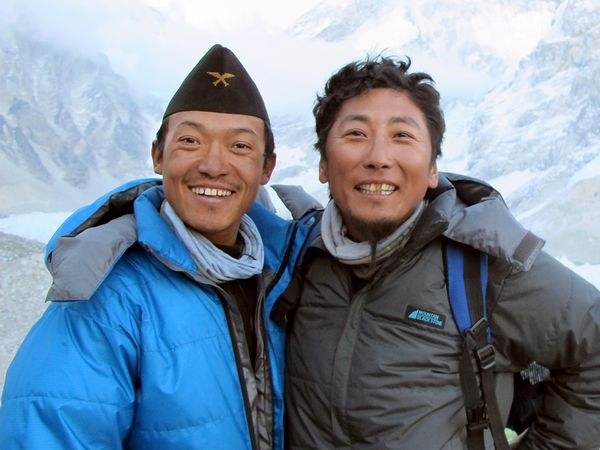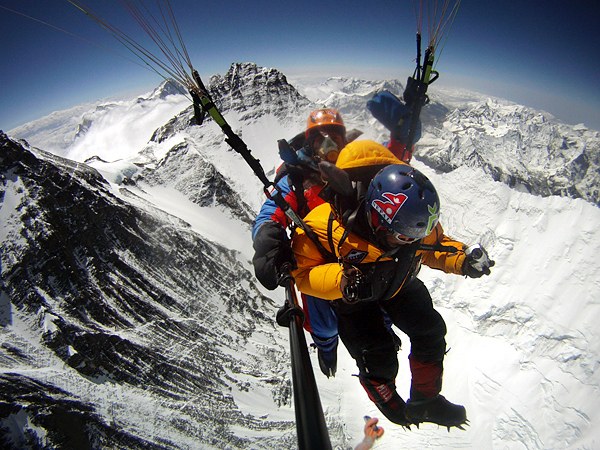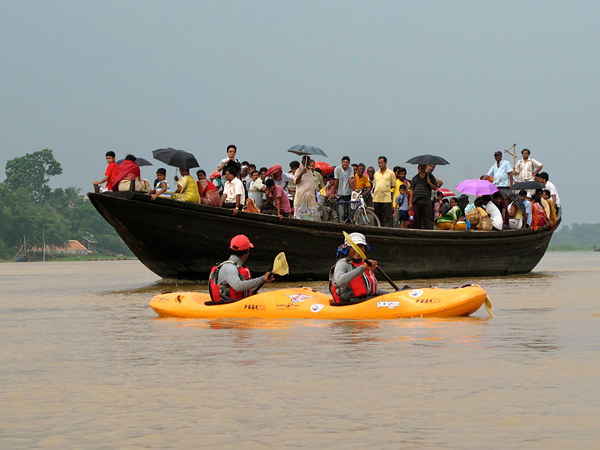National Geographic 2012 Winners: Sano Babu Sunuwar and Lakpa Tsheri Sherpa
The votes—nearly 72,000 of them—are in, and we're pleased to announce that Sano Babu Sunuwar and Lakpa Tsheri Sherpa are the 2012 People's Choice Adventurers of the Year. Their Ultimate Descent expedition to climb Everest, paraglide down, and paddle to the sea truly embodies the spirit of adventure. With borrowed gear and a bare-bones budget, there were no corporate sponsors nor social media campaigns, just the essentials for adventure—vision, creativity, and friendship.
The Ultimate Descent: Lakpa Tsheri Sherpa and Sano Babu Sunuwar
Two Nepalis complete a mission to launch a paraglider from Mount Everest’s summit and kayak the Ganges to the Indian Ocean.
When Lakpa Tsheri Sherpa first saw paragliders arrive in the Himalaya, he dreamed of flying above the massive peaks of his home—the Khumbu region. After his third successful summit guiding trip on Everest, he viewed paragliding as a simpler, faster, and more graceful way of descending through the peak’s perilous slopes.
In October of 2010, Lakpa borrowed a paraglider, got a few pointers, and launched from a hillside above his home. He promptly crashed into a tree. With his paraglider wing badly damaged, Lakpa set out for the town of Pokhara, considered to be the gathering spot for paragliders, to seek repairs and find a mentor. He ran into Sano Babu Sunuwar, whom Lakpa had met years earlier on Island Peak. Babu repaired the glider and the two men hatched the plan for the Ultimate Descent.
They would climb to the world’s highest point, launch a paraglider and fly for as long as possible, bicycle to a point where streams gathered into rivers, kayak across the Nepali border into India, and paddle the Ganges River all the way to the Indian Ocean. It would be an unprecedented first, but it was the overall combination of sports, audacity, and friendship that drew the duo to the idea. Babu, 28, had no climbing experience. Lakpa, 39, had never kayaked and didn’t even know how to swim.
In April of 2011, the duo had borrowed gear, slapped a basic plan together, and began their ascent of Everest. On May 21, they became the third party to launch a paraglider from the summit and set a new world record of 8,865 meters for free flight in the process. On the Kosi River’s Class V rapids, Babu got caught recirculating in a massive whirlpool in their two-man kayak, while Lakpa floated down river. Once they reached the Ganges, they paddled flatwater through unfamiliar country. They were robbed at knifepoint and had to live off fruit trees. After 850 kilometers, Lakpa and Babu reached the Bay of Bengal. On June 27, they became the first people to complete the descent from Everest’s summit to the Indian Ocean.
“When we arrived on the beach, we were frightened. We were surrounded by giant red scorpions,” says Babu. Later after showing pictures to friends, he would learn that these “scorpions” were in fact harmless crabs.
The Ultimate Descent team earned recognition from the international paragliding community, and the Nepali press hailed them as national heroes. Western adventurers admired their spunk, simplicity, and bare-bones budget. There were no social media campaigns, corporate sponsors, or expedition websites, just the essential ingredients for adventure—vision, creativity, and friendship.
—Fitz Cahall
THE INTERVIEW
Adventure: Babu, as a kayaker and paraglider, what was the most difficult part of the journey?
Sano Babu Sunuwar: On Everest I felt a great deal of discomfort. It was hard to breathe. Lakpa told me, “You are Sherpa. Be strong.” I am not a climber, but this was a great dream of mine to climb Mount Everest. Lakpa had done this many times. He helped me a great deal.
A: What was the most intimidating part of the journey?
Lakpa Tsheri Sherpa: The bugs. The ants. All animals—so active. Insects—so active. They are also busy. People so active. In the mountains, all creatures move slowly. In India, all the animals and the people move so fast. They are not still. I did not like the bugs. When we reached the ocean and took the kayaks to shore, the beach was covered in giant red scorpions. I was scared then, but we learned later that they were crabs and harmless. I also had a hard time breathing in the low elevation.
A: While the flight from Mount Everest might be the most eye-popping part of your adventure, it sounds like the Ganges and India were also difficult?
SBS: Sometimes whole villages would come down. We were robbed. They came with knives. We protected the camera, but gave them money. They left, but we paddled very fast. We could hear them coming with a motorboat. We found an island with tall grasses and hid. We slept in the kayaks the whole night.
LTS: We ate fruit from the trees, but the water was bad. We were not used to seeing dead bodies. In Nepal, we burn our dead. In India, they are put in the river. We would see two or three bodies a day.
A: For each of you, was there a favorite part of the journey?
SBS: Taking off from the highest point in the world. At first it was really windy, but the wind calmed. When we lifted off we were carried immediately upward.
LTS: The flight. I like to sing while I fly. We were very happy. We were both singing. This was a dream for both of us.
A: The "ultimate descent" earned you some attention both in Nepal and abroad. There was a short film made about your flight. What has it been like to be recognized for your achievement?
SBS: We love getting to share our dream. We came to Europe to show the film at a film festival. We feel a little like movie stars. People wanted to shake our hands. We were very happy to share our story.
LTS: When we got home, we were very excited to share our story not just with Nepal, but all over the world. It felt like a million people. There were a lot of foreigners who came to set records. We weren’t after a record, we just wanted to do all these things, climbing, paragliding, kayaking in one continuous trip


